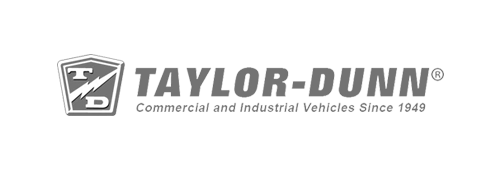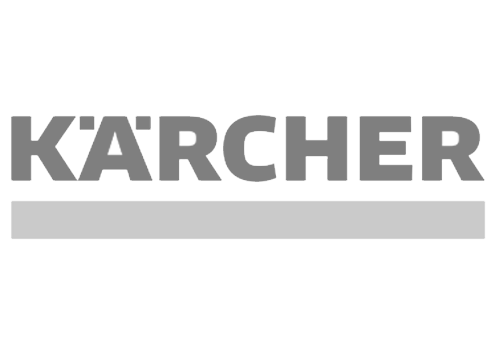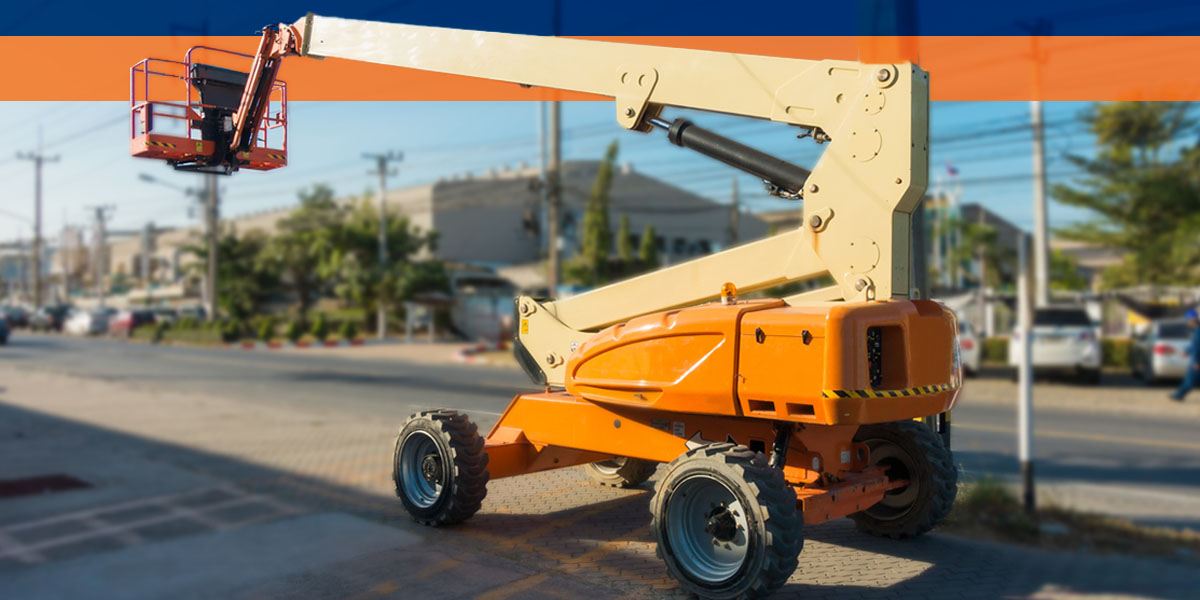
Every job site requires specific equipment to get the job done. Workers often need to work from high places with more security than a simple ladder can provide. Other times, setting up complex scaffolding structures could be more time-consuming than the actual task should take. This is where aerial lifts come into play.
Aerial lifts give workers stable, flexible access to high places on the job site by means of aerial work platforms. When you’re on the market to buy or rent an aerial lift, you must make sure you’re choosing the right one for your needs that will help you complete your task in the most efficient way possible.
What Are the Different Types of Aerial Lifts?
When it comes to aerial lifts, there are three main types you should know about: scissor lifts, boom lifts, and vertical mast lifts. While they may appear similar at first glance, each of these lifts serves a unique purpose and is best suited for different jobs and environments.
1. Scissor Lift
A scissor lift’s base is the same size as the aerial work platform. The platform rises vertically, giving workers access to areas directly overhead of the base. Often, the aerial work platform has an extension deck to increase the horizontal distance that workers can access when performing their tasks. The height they can reach varies from 10 feet to over 20 feet, depending on the manufacturer and model.
The two main types of scissor lifts are:
- Electric slab scissor lifts: Electric scissor lifts run on electricity. This makes them ideal for indoor job sites where workers must keep emissions to a minimum.
- Rough terrain scissor lifts: Rough terrain scissor lifts can be either engine-powered or hybrid and are ideal for outdoor work where rough terrain is present. They generally can lift more workers at once and have four-wheel drive options for easier job site navigation.
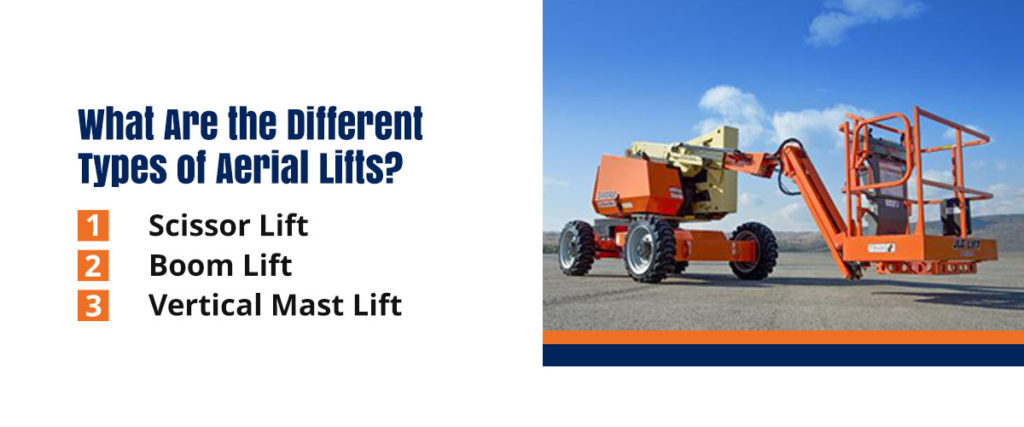
2. Boom Lift
Boom lifts help workers access hard-to-reach, high places. They provide a sturdy base, raising and moving the aerial work platform via an extendable, controllable arm or boom. Boom lifts provide vertical and horizontal control, giving workers greater flexibility when approaching the area where they’ll be working. Boom lifts can reach areas at least 30 feet high and beyond 100 feet high.
Here are three of the main types of boom lifts:
- Telescopic boom lifts: Telescopic boom lifts raise the aerial work platform via a boom that extends in a straight line from the base, like a collapsable telescope.
- Articulating boom lifts: The boom on an articulating boom lift has several sections connected by hinges that articulate. This allows workers to access areas that are extremely difficult to reach, moving the aerial work platform over barriers and obstacles.
- Towable boom lifts: Towable boom lifts offer easy transportation for construction companies who need to access high places on their job site. They can hitch to the back of a pickup truck, removing the need for heavy machinery to transport a larger boom lift. These lifts can be electric or gas-powered.
3. Vertical Mast Lift
Vertical mast lifts raise workers on the aerial work platform via a mast or vertically articulating arm. They take up little space and are relatively lightweight, making them ideal for more crowded work sites. Both self-powered and push-around vertical mast lifts exist, although push-around vertical mast lifts require outriggers for proper stability.
Which Lift Is Best for Your Application?
Here are some questions to ask to help you choose the best aerial lift for your application:
- How high do you need to go? The height you need to reach will affect which types of aerial lifts you should consider. A telescoping boom lift can help you reach maximum heights, while scissor lifts or a vertical mast lift might be a better choice for lower applications.
- Are there obstacles in the way? Obstacles will present a challenge on some job sites, but you can get around them with the right aerial lift. A telescoping boom lift can help you reach areas with obstacles directly beneath, while an articulating boom lift can help you get over and around obstacles in flexible ways. If no obstacles are present, you may be able to approach the work area with a towable boom lift, scissor lift or vertical mast lift.
- How many workers will be in the lift at the same time? Some work tasks require several employees in the aerial lift simultaneously. In these instances, you may need a rough terrain scissor lift or a boom lift. Electric slab scissor lifts and vertical mast lifts are ideal when fewer workers need to be on the aerial lift platform at a time.
- Do you need a power source? Sometimes, the need for a power source will necessitate certain types of aerial lifts on the job site. Electric-powered lifts need a way to recharge. If no power source is present, a gas-powered aerial lift will be the right option.
Factors to Consider When Choosing an Aerial Lift
Besides asking yourself the above questions, there are some unique factors you need to consider. Understanding how the following factors affect your job site will help you choose the right aerial lift for your needs:
- Manufacturer: Research the best manufacturers of aerial lifts. This is especially important if you’re looking to buy a new or used aerial lift, but it’ll also affect your experience when renting one.
- Indoor vs. outdoor work: Indoor and outdoor job sites have very different needs, so consider where you’re working when choosing an aerial lift. This includes factors like available power sources, obstacles and the kind of terrain you’ll be working on.
- Available space and movement requirements: Analyze your job site to know how much space you’ll have to work with regarding the use of your chosen aerial lift. Tighter working environments may require an aerial lift that takes up minimal space with flexible movement options. If you have plenty of space to work with and need the extra weight handling and height, you may be able to use a boom lift.
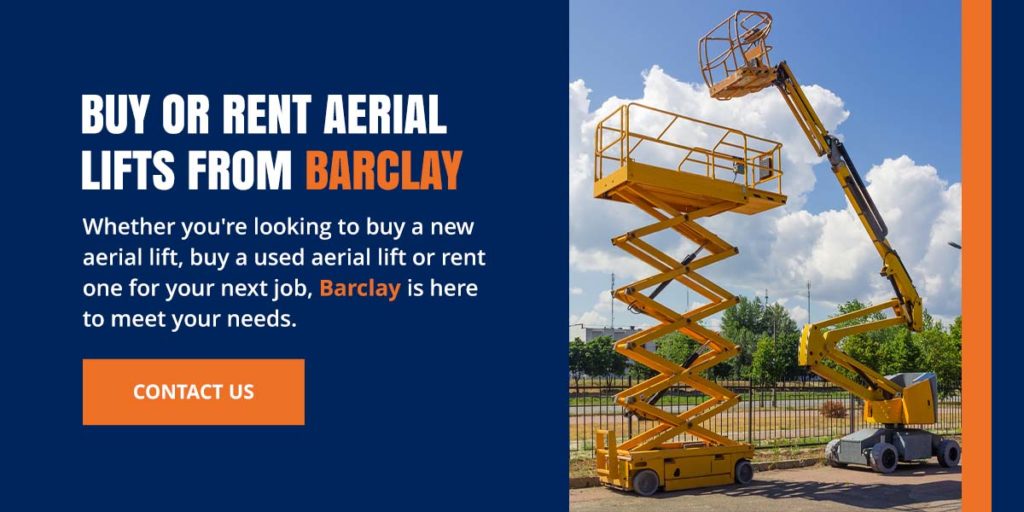
Buy or Rent Aerial Lifts From Barclay
Whether you’re looking to buy a new aerial lift, buy a used aerial lift or rent one for your next job, Barclay is here to meet your needs. With aerial lifts from JLG, Genie, and Yale, we can help. We’ve become the premier equipment solution in the New Jersey and Southern New York areas and can be your trusted source for material handling equipment, helping you achieve greater, safer heights on your job site.
We invite you to contact us today if you have any more questions or want to take the next step toward getting the aerial lift you need!


